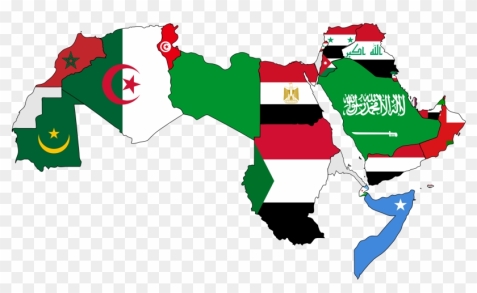“We were not born to beg from anyone. We represent the pride of the Arab nation. We represent the dignity of the Arab nation. We are the heart of the Arab nation. We are the vanguard of the Arab nation. We are the hope of the Arab nation. We are the revolution of the Arab nation. We are the custodians of Arab nationalism and we are the custodians of Arab unity, brothers.
(Foreign Broadcast Information Services 1981b, p. I10)”
 During the 1960s we see Arab Nationalism the political movement championed by the Egyptian President, Gamal Abdul Nasser gain prominence within the Middle East. I would go as far as to say that Arab Nationalism’s concept of freedom, socialism and unity formed the basis of many of the 1960s revolutions against colonial rule and influence across the Middle East. This is evident in the case of the September 1st Revolution launched by the Free Unionist Officers movement led by Gaddafi and his associates in Libya.
During the 1960s we see Arab Nationalism the political movement championed by the Egyptian President, Gamal Abdul Nasser gain prominence within the Middle East. I would go as far as to say that Arab Nationalism’s concept of freedom, socialism and unity formed the basis of many of the 1960s revolutions against colonial rule and influence across the Middle East. This is evident in the case of the September 1st Revolution launched by the Free Unionist Officers movement led by Gaddafi and his associates in Libya.
What begun originally as an Anti-Colonial revolution against King Idris and Western involvement in Libya evolved into an Arab Nationalist Revolution from Above where Gaddafi implemented reforms in Libya. The reforms stressed the need to embrace the “pride of the Arab nation”, Arab Unity and self-reliance within the Arab nation outside of Western influence. Arab nationalism within Libya emphasised the notion of brotherhood and anti-imperialism. This concept of a continual revolution and reforms in Libya can be described as their form of resistance against imperialism and the West. However, a question is raised of what are the roots and manifestation of Arab nationalism in Libya and how has it shaped Libya during the course of the continual revolution which is Gaddafi’s regime.
Historiography looking at the ideology at the centre of the state of Libya highlights how Arab Nationalism has shaped the governing of Libya, state formation, Libya’s relationship with other Arab states and the West resulting in the total transformation of the state. Strausz-Hope and Possony state that there are two types of ideologies. An ideology can be a DRIVE where it dominates the followers and its leader, or it can be a tool where the leader consciously uses it as a way of enlisting greater obedience among his followers, however, he doesn’t believe it himself but over time due to his emphasis of the ideology he begins to believe it. Ronald Bruce St. John, however, says the unique case of Gaddafi is that his ideology of Arab Nationalism has been both the tool and drive since the September 1st revolution.
When examining the roots of Arab Nationalism in Libya, St. John research into Libya’s revolution and Gaddafi ideology in two of his articles highlight that Arab Nationalism was exposed to Libya through media outlets such as radio stations in Cairo “Voices of the Arabs”. The topics discussed on Arab radio stations and the political environment within the Middle East shaped Gaddafi’s concept of Arab Nationalism. The 1952 Egyptian Revolution, the 1956 Suez Canal Crisis, The 1958 Arab-Syria Union and Abdul Nasser’s Anti Imperialist, Arab Nationalist foreign policies and socialist reforms implemented during the Egyptian Revolution gained much support in Libya and across the Middle East encouraging Gaddafi to pursue this Arab Nationalist centred revolution in Libya. St John highlights in his article that Gaddafi drew more than inspiration from Nasser’s Revolution but rather Libya’s revolution was modelled on it from stage to stage. Like Nasser, Arab Nationalism was central to the revolution as there was an emphasis on the glorification of “Arab history and culture” as Gaddafi viewed Libya as the “custodian of Arab nationalism.” In Gaddafi’s revolution, he wanted to rid the country of the western notions of “capitalism, communism and imperialism” as his first months of the revolution focused on national independence as he attempted to increase the use of Arabic within the nation emphasising on nationalistic pride and the symbolism of it. With the revolution having Arab nationalism at the centre he aimed to end what he deems the “backwardness” of the Arab nation due to what he considered the “four years of stagnation under the Ottoman rule, …exploitation of first colonialism and then imperialism…. and corruption of… monarchical rule.
Therefore, what Western critics perceive as a coup d’état was rather an Anti-Colonial revolution and the beginnings of a continual Arab Nationalist Revolution, emphasising the idea of Libya continually reinventing itself.
References
Ronald Bruce. St. John, “The Ideology of Muammar Al-Qadhdhafi: Theory and Practice.” International Journal of Middle East Studies15, no. 4 (1983): 471-90. http://www.jstor.org/stable/163557.
Ronald Bruce St John. (2008) Redefining the Libyan revolution: the changing ideology of Muammar al-Qaddafi, The Journal of North African Studies, 13:1, 91-106, DOI: 10.1080/13629380701742819
Nathan Alexander. “Libya: The Continuous Revolution.” Middle Eastern Studies 17, no. 2 (1981): 210-27. http://www.jstor.org/stable/4282828.
Raymond A. Hinnebusch. “Charisma, Revolution, and State Formation: Qaddafi and Libya.” Third World Quarterly 6, no. 1 (1984): 59-73. http://www.jstor.org/stable/3991227.

